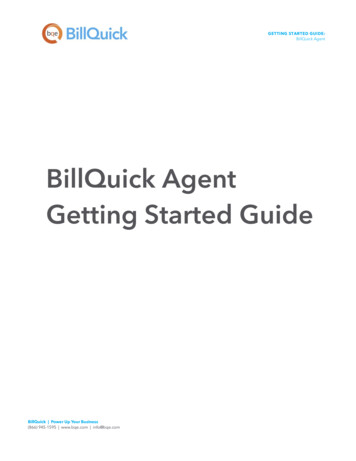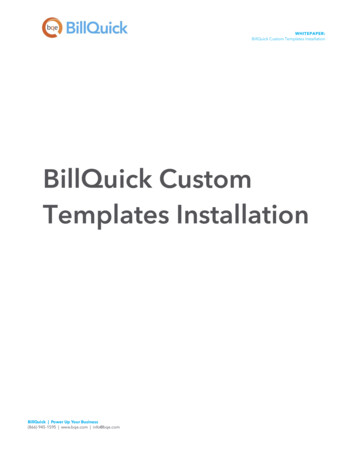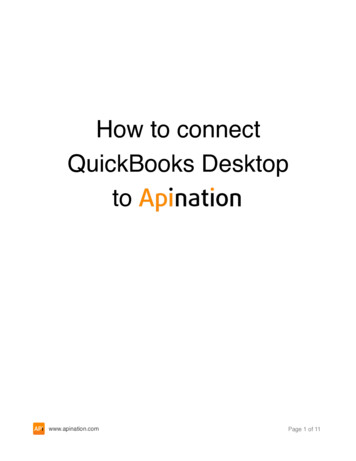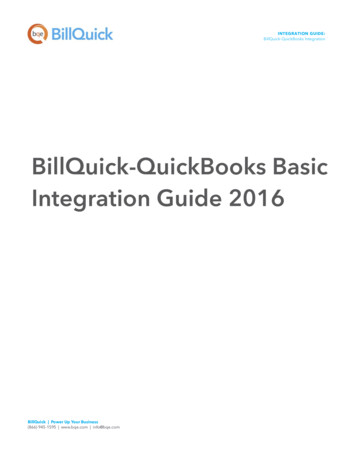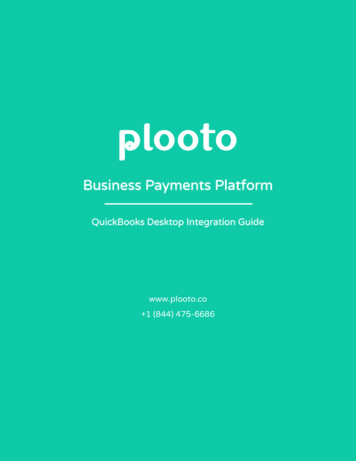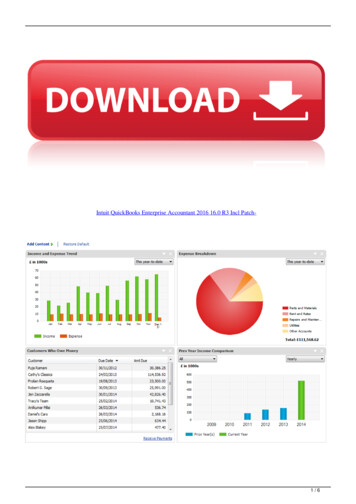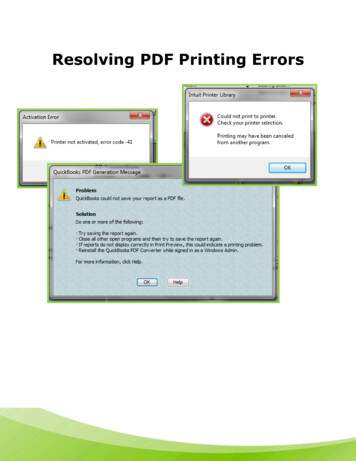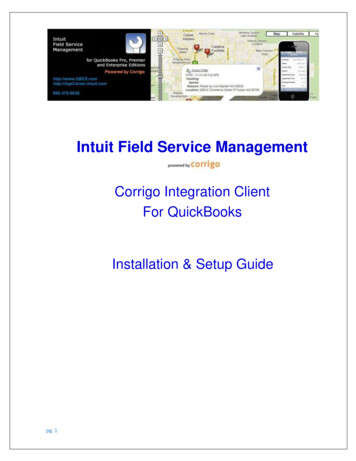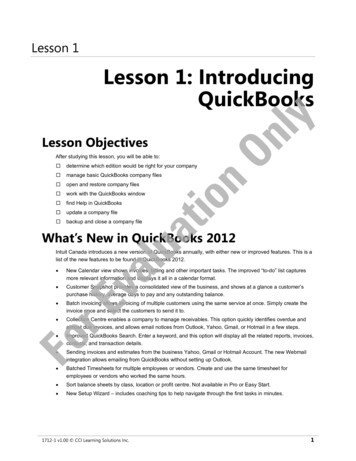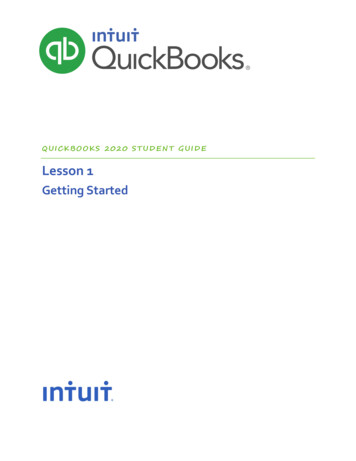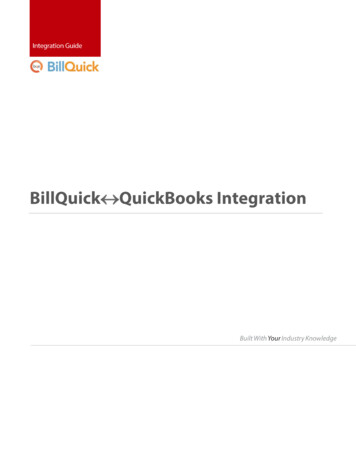
Transcription
ContentsINTRODUCTION . 1Software Editions Supported .1INTEGRATION BASICS . 2MODES OF SYNCHRONIZATION .3INTEGRATION RULES.3INTEGRATION SETTINGS .4DATA INTEGRATION. 5INITIAL INTEGRATION .5DATA VERIFICATION .8DAY-TO-DAY INTEGRATION .9BEST PRACTICES .10
IntroductionIntroductionData integration between BillQuick (by BQE Software) and QuickBooks (by Intuit) can make your timebilling, accounting and financial management tasks easier. Full-featured, BillQuick helps you manageyour company, whether your time, expense, billing and reporting needs are simple or you requirecomplex billing, reporting and management capabilities. QuickBooks is a business accounting softwarethat provides solutions such as general accounting, accounts receivable, accounts payable, onlinebanking, reporting, payroll, and other functions. Integrated, BillQuick and QuickBooks deliver a virtualprogram that ensures data accuracy, eliminates time-consuming duplicate manual entry, enhancesflexibility, and increases control over your bottom line.The goal of this BillQuick QuickBooks Basic Integration Guide is to help you understand the basics ofdata integration between BillQuick and QuickBooks. BillQuick controls integration, enabling you tochoose accounts, what data flows between the programs, and much more. BillQuick automaticallycreates smart connections using your settings and its built-in intelligence.Check out BillQuick Training and Services for a standard or custom trainingcourse on data integration with QuickBooks. BQE Software also offersConsulting services in these areas.Software Editions SupportedAll BillQuick editions – Basic (Microsoft Access database), Pro (Microsoft Access and SQL Expressdatabase) and BillQuick Enterprise (Microsoft Access, SQL Express and Microsoft SQL Server database) –integrate with the following QuickBooks editions: QuickBooks Pro/Premier editions all flavors, including the Accountant’s Edition (2002and later)QuickBooks Enterprise Solutions all flavors, including the Accountant’s Edition (3.0 andlater)QuickBooks Canadian Edition (2004 and later)QuickBooks UK (2003 and later)QuickBooks Australia (2008 and later)We do not support QuickBooks Plus edition.BillQuick QuickBooks Basic Integration Guide 2014 v.3Page 1
Integration BasicsIntegration BasicsWhether you have a technical background or not, it is helpful to understand the basics ofBillQuick QuickBooks integration. This can help you visualize what is happening behind the scenes asBillQuick manages the transfer of data to and from QuickBooks.There are some differences between QuickBooks and BillQuick that need to be understood in order toensure smooth and accurate data integration. BillQuick is project-centered and supports a hierarchicalstructure while as QuickBooks is client-centered and uses a flat project structure. Each record commonto BillQuick and QuickBooks share a unique Link ID that identifies them as related. This does not meandata in both databases is exactly the same; only that they share common data. BillQuick Project recordscontain data and options that QuickBooks Job records do not and vice versa. What is important forintegration are that the two programs share key data.The table below shows the direction data can potentially flow between BillQuick and QuickBooks.Whether it flows in one direction or the other (or both directions) depends on choices made on theIntegration Settings screen. You can be very specific in determining how data flows to and fromBillQuick, and also which General Ledger accounts in QuickBooks are posted.BillQuickTable NameDataflowQuickBooksTable NameActivity Codes Service ItemExpense Codes Other Charge ItemEmployee EmployeeVendor VendorClient CustomerProject JobTime Entry Time TrackingExpense Log Checks and Credit CardsInvoice InvoicePayment PaymentVendor Bills BillsChart of Accounts Chart of AccountsEstimate EstimateTo review detailed, field-by-field mapping of records between QuickBooksand BillQuick, see BillQuick Help, BillQuick QuickBooks Integration, Table andField Mapping.As you can see above, integration of BillQuick with QuickBooks is very comprehensive. BillQuick createsa log that records the events and exceptions involved in data synchronization with QuickBooks. It flagsthis log file with a date stamp.BillQuick QuickBooks Basic Integration Guide 2014 v.3Page 2
Integration BasicsBottom Line: The major benefit is that you do not have to re-enter BillQuick data into QuickBooks.BillQuick manages the process, using your synchronization settings.Modes of SynchronizationBillQuick offers three modes of synchronization with QuickBooks.SynchronizationQuickBooks1Real-Time On-Schedule On-Demand 1Requires QuickBooks 2004 or laterReal-Time Synchronization means that data integrates between BillQuick and QuickBooks when youupdate a record in either program. It is completely automatic and requires no action on your part.However, you will need to specify this option in the QuickBooks Integration Wizard or QuickBooks menuonly once and then from that point onwards, data is synced automatically.In contrast, On-Schedule Synchronization means that BillQuick reminds you to sync on the schedule youchoose. The schedule may be set in the Global Settings screen.On-Demand Synchronization allows you to transfer all updated data or just one record at a time,whenever you want. BillQuick includes a Send To QuickBooks option on many screens that enables youto send a new or changed record to QuickBooks instantly and directly from that screen.Generally, for batch or group data synchronization, you would use the Integration menu, QuickBooks,Get or Send submenu. The menu provides various synchronization options enabling you to controlsending and getting data.BillQuick identifies the records that have a corresponding record inQuickBooks by displayingin the grids.Integration RulesBillQuick handles most of the time and billing data differently from QuickBooks. To ensure accuracy andcompleteness of data transfer, BillQuick QuickBooks integration follows a set of rules. Some of theserules may not be relevant for the first-time data transfer but shall apply in future synchronization.Check out the BillQuick-QuickBooks Advanced Integration Guide fordetails.BillQuick QuickBooks Basic Integration Guide 2014 v.3Page 3
Integration BasicsIntegration SettingsIn BillQuick, you can specify data transfer rules and settings in the BillQuick-QuickBooks IntegrationSettings screen. You can also restrict the data sent from or transferred to BillQuick by setting filters.These settings apply company-wide and are used as defaults when you choose to sync data betweenBillQuick and QuickBooks.A key step in the integration process is to assign general ledger (G/L) accounts to BillQuick activity codes,expense codes and other invoice items prior to the synchronization. This is because QuickBooks requiresG/L accounts for all items and transactions. You can assign G/L accounts to individual items or specifythem at the project level. This is done from the BillQuick-QuickBooks Integration Settings screen.BillQuick also allows you to assign QuickBooks payroll items and accounts to its payroll items such asregular time, overtime, and vacation on an employee or employee group basis.You can transfer classes from QuickBooks and assign them to BillQuick items such as activities, expensecodes and even projects. QuickBooks classes can be assigned to individual items or their groups.QuickBooks accounts and classes are available for assignment in BillQuickafter a connection has been established between the two programs.Thus, using the BillQuick-QuickBooks Integration Settings screen, you can specify the following: Send SettingsGet SettingsAccount AssignmentsPayroll SettingsClass AssignmentsCheck out the BillQuick-QuickBooks Advanced Integration Guide orBillQuick Help for details.BillQuick QuickBooks Basic Integration Guide 2014 v.3Page 4
Data IntegrationData IntegrationInitial or first-time integration populates the BillQuick or QuickBooks company database withinformation from the other program. Your initial synchronization settings determine what informationand how much of it is shared between the programs. For example, you may decide to move QuickBooksdata for only the last two years to BillQuick. The first-time integration brings the databases of the twoprograms to the same level.To gain the most complete and useful practice management information from the start and to reducesetup time, we recommend that you add or setup master information, and other time and billing data inyour BillQuick database.It is preferable to create activity (service) and expense (other charge)items in QuickBooks and have them transferred into BillQuick. This reduces thestep of creating or assigning G/L accounts for them in BillQuick.For data integration, you can specify synchronization options on the BillQuick-QuickBooks IntegrationSettings screen and then use the Integration menu to transfer each type of data. Alternatively, you couldmake use of QuickBooks Integration Wizard in BillQuick, as an easier and faster method for first-timeintegration. This wizard walks you through the process of specifying initial synchronization options,mapping of accounts and items, and finally the transfer of data.Initial IntegrationTypically, there are four possible scenarios for first-time integration: New BillQuick-Existing QuickBooks UserExisting BillQuick-Existing QuickBooks UserNew BillQuick-New QuickBooks UserExisting BillQuick-New QuickBooks UserThe steps involved in the first-time integration are very simple:1. Create a new company file or back up an existing company file in BillQuick or QuickBooks.2. Grant access rights to BillQuick in your QuickBooks program.3. Specify synchronization settings in the BillQuick-QuickBooks Integration Settings screen. Later,fine-tune these settings for day-to-day integration process. Get Settings and Send Settings for each BillQuick module (or skip the synchronization forsome modules)BillQuick QuickBooks Basic Integration Guide 2014 v.3Page 5
Data Integration QuickBooks account assignment for BillQuick items (activities, expenses, invoice lineitems)Payroll settings for BillQuick payroll itemsQuickBooks class assignment for BillQuick items (activities, expenses and projects)4. Decide the type of data integration or synchronization mode: On-Demand On-Schedule Real-Time Synchronization5. Start data synchronization using Integration menu, QuickBooks, Send to QuickBooks or Get fromQuickBooks.BillQuick QuickBooks Basic Integration Guide 2014 v.3Page 6
Data IntegrationBelow are the BillQuick Send and Get menu items and the corresponding QuickBooks screens.BillQuickMenu rClient*CustomerProject*JobActivity*Service ItemAccountsChart of AccountsExpense*Other Charge ItemEstimatesEstimateExpense LogChecks and Credit CardsTime EntryTime TrackingVendor BillsBillsInvoicesInvoicesPaymentsPayments* The screen name may be different based on your profession or industry, or if youcustomized them using the BillQuick Custom Labels feature.BillQuick QuickBooks Basic Integration Guide 2014 v.3Page 7
Data IntegrationData VerificationWhen initial data transfer is complete, you can open the corresponding screens in BillQuick andQuickBooks for a quick verification. Data touch-up maybe needed in either BillQuick or QuickBooks. Thisensures that your information is accurate and complete.To avoid data duplication in case of existing users, use the BillQuickQuickBooks Smart Match feature to link and un-link records between the twoprograms. You need to do it only once and then from that point onwards, datawill sync accordingly. To save time, skip matching of inactive records.BillQuick offers many ways to verify the transferred data. You can switch between correspondingscreens in both programs and check the data.As part of the integration feature, BillQuick also provides QuickBooks Sync Reports. Acting as auditreports to verify data transfer, they show which records are linked and unlinked between BillQuick andQuickBooks.BillQuick QuickBooks Basic Integration Guide 2014 v.3Page 8
Data IntegrationBillQuick also creates a log file that lists all records that were transferred from or to QuickBooks alongwith the exceptions.Check the BillQuick-QuickBooks Advanced Integration Guide and BillQuickHelp, BillQuick QuickBooks Integration section for details.Day-to-Day IntegrationAfter data verification, you may want to review your current synchronization settings to determine ifthey should be fine-tuned for day-to-day integration.After initial integration, you may set integration rules so that master information is maintained inBillQuick and transfers only to QuickBooks. It is a good practice to maintain clients, projects, time andexpenses, billing, accounts receivables, payments and reports in BillQuick. QuickBooks should be usedfor functions such as accounts payable, general ledger, banking, payroll and financial statements. Thefollowing best practices give an idea about the common breakdown of tasks you should be doing inBillQuick and QuickBooks.BillQuick QuickBooks Basic Integration Guide 2014 v.3Page 9
Data IntegrationBest PracticesItemsEmployeesBillQuickQuickBooks Vendors Activity/Service items Expense/Charge Items Clients Projects ClassesEstimates and Budgets Service Fee Schedules Chart of AccountsTime Entries Employee Expenses Vendor Bills Invoices Payments Checks and Credit Card Bills Payroll Items Billing Accounts PayableAccounts Receivable Reports Financial Statements Banking Congratulations! You have gained a basic understanding of data integration between BillQuick andQuickBooks. To learn more, check the BillQuick-QuickBooks Advanced Integration Guide, BillQuick Helpor attend a training course.For more information, visit us at www.bqe.com. If you have any trouble in using our integration tool,please contact BillQuick Support at (310) 602-4030 or Support@bqe.com. For other questions, please callus at (888) 245-5669 (US and Canada) or (310) 602-4020; or email Sales@bqe.com.BillQuick QuickBooks Basic Integration Guide 2014 v.3Page 10
1 Requires QuickBooks 2004 or later Real-Time Synchronization means that data integrates between BillQuick and QuickBooks when you update a record in either program. It is completely automatic and requires no action on your part. However, you will need to specify this option in the QuickBooks
